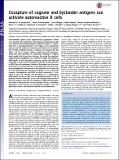Cocapture of cognate and bystander antigens can activate autoreactive B cells
Author(s)
Sanderson, Nicholas S. R.; Zimmermann, Maria; Eilinger, Luca; Gubser, Céline; Schaeren-Wiemers, Nicole; Lindberg, Raija L. P.; Dougan, Stephanie K.; Kappos, Ludwig; Derfuss, Tobias; Ploegh, Hidde; ... Show more Show less
Download734.full.pdf (1.557Mb)
PUBLISHER_POLICY
Publisher Policy
Article is made available in accordance with the publisher's policy and may be subject to US copyright law. Please refer to the publisher's site for terms of use.
Terms of use
Metadata
Show full item recordAbstract
Autoantibodies against myelin oligodendrocyte glycoprotein (MOG) are associated with autoimmune central nervous system diseases like acute disseminated encephalomyelitis (ADEM). For ADEM, it is speculated that a preceding infection is the trigger of the autoimmune response, but the mechanism connecting the infection to the production of MOG antibodies remains a mystery. We reasoned that the ability of B cells to capture cognate antigen from cell membranes, along with small quantities of coexpressed “bystander” antigens, might enable B-cell escape from tolerance. We tested this hypothesis using influenza hemagglutinin as a model viral antigen and transgenic, MOG-specific B cells. Using flow cytometry and live and fixed cell microscopy, we show that MOG-specific B cells take up large amounts of MOG from cell membranes. Uptake of the antigen from the membrane leads to a strong activation of the capturing B cell. When influenza hemagglutinin is also present in the membrane of the target cell, it can be cocaptured with MOG by MOG-specific B cells via the B-cell receptor. Hemagglutinin and MOG are both presented to T cells, which in turn are activated and proliferate. As a consequence, MOG-specific B cells get help from hemagglutinin-specific T cells to produce anti-MOG antibodies. In vivo, the transfer of MOG-specific B cells into recipient mice after the cocapture of MOG and hemagglutinin leads to the production of class-switched anti-MOG antibodies, dependent on the presence of hemagglutinin-specific T cells. This mechanism offers a link between infection and autoimmunity. Keywords: tolerance; autoantibodies; antigen capture; antigen presentation; influenza
Date issued
2017-01Department
Massachusetts Institute of Technology. Department of BiologyJournal
Proceedings of the National Academy of Sciences
Publisher
National Academy of Sciences (U.S.)
Citation
Sanderson, Nicholas S. R. et al. “Cocapture of Cognate and Bystander Antigens Can Activate Autoreactive B Cells.” Proceedings of the National Academy of Sciences 114, 4 (January 2017): 734–739 © 2017 National Academy of Sciences
Version: Final published version
ISSN
0027-8424
1091-6490